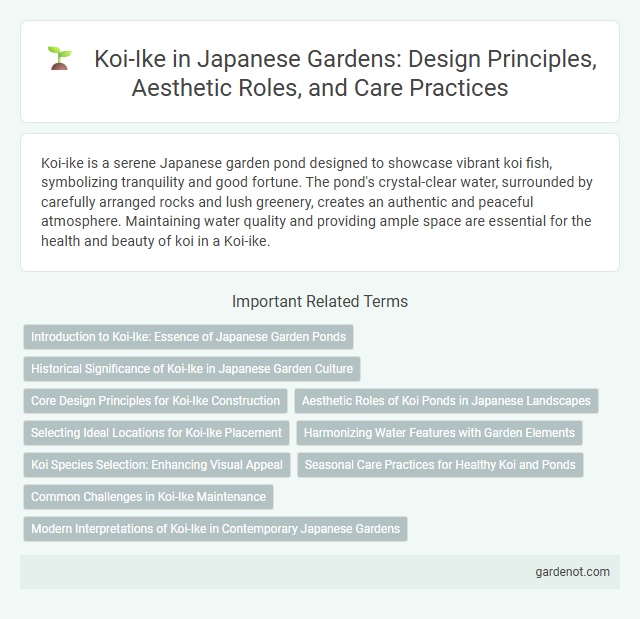Koi-ike is a serene Japanese garden pond designed to showcase vibrant koi fish, symbolizing tranquility and good fortune. The pond's crystal-clear water, surrounded by carefully arranged rocks and lush greenery, creates an authentic and peaceful atmosphere. Maintaining water quality and providing ample space are essential for the health and beauty of koi in a Koi-ike.
Introduction to Koi-Ike: Essence of Japanese Garden Ponds
Koi-ike, or koi ponds, are a quintessential feature of Japanese gardens, symbolizing tranquility and harmony with nature. These meticulously designed ponds host vibrant koi fish, which represent perseverance and good fortune in Japanese culture. The careful placement of rocks, water plants, and water flow in Koi-ike enhances the aesthetic balance and meditative atmosphere central to traditional Japanese garden design.
Historical Significance of Koi-Ike in Japanese Garden Culture
Koi-ike ponds have played a vital role in Japanese garden culture since the Heian period, symbolizing peace, prosperity, and beauty. Historically, these ponds were carefully designed to reflect harmony with nature, serving both aesthetic and spiritual purposes in traditional gardens. The presence of koi fish in these ponds represents perseverance and good fortune, deeply embedded in cultural beliefs and artistic expressions.
Core Design Principles for Koi-Ike Construction
Koi-ike construction centers on harmony between natural elements and water flow, ensuring a balanced ecosystem that supports koi health. Key design principles emphasize optimal pond depth, gradual slopes for safe koi movement, and strategic placement of rocks and aquatic plants to mimic natural habitats. Water clarity and oxygenation systems are integrated seamlessly to maintain water quality and enhance the aesthetic appeal of the garden.
Aesthetic Roles of Koi Ponds in Japanese Landscapes
Koi-ike, or koi ponds, serve as central aesthetic elements in Japanese gardens, symbolizing tranquility and harmony while enhancing visual appeal through their reflective surfaces and vibrant koi fish. The careful design of water features and aquatic life contributes to a balanced ecosystem, emphasizing natural beauty and spiritual contemplation. These ponds often incorporate traditional materials and landscaping techniques to create serene environments that evoke peacefulness and cultural significance.
Selecting Ideal Locations for Koi-Ike Placement
Choosing the ideal location for koi-ike in a Japanese garden requires careful consideration of sunlight exposure, water depth, and natural surroundings to ensure optimal koi health and aesthetic harmony. Positioning the pond where it receives partial sunlight helps maintain water temperature and supports aquatic plant life crucial for filtration. Integrating the koi-ike near rocks, trees, and traditional garden elements enhances visual appeal while providing shade and shelter for the koi.
Harmonizing Water Features with Garden Elements
Koi-ike ponds embody the harmonious integration of water features with traditional garden elements, creating a tranquil atmosphere that enhances the aesthetic appeal of Japanese gardens. The vibrant koi fish add dynamic movement and color, while carefully designed stone lanterns, bridges, and lush greenery frame the pond, establishing a balanced ecosystem. This synergy of aquatic life and natural surroundings fosters meditation and reflects the principles of Wabi-Sabi and Zen in garden design.
Koi Species Selection: Enhancing Visual Appeal
Koi-ike ponds thrive with a carefully curated selection of koi species, emphasizing vibrant coloration, diverse scale patterns, and harmonious size variations to enhance visual appeal. Breeders prioritize popular varieties such as Kohaku, Taisho Sanke, and Showa for their striking red, white, and black markings that create captivating contrasts. Incorporating rare breeds like Utsurimono and Asagi introduces unique hues and patterns, elevating the pond's aesthetic complexity and cultural authenticity.
Seasonal Care Practices for Healthy Koi and Ponds
Seasonal care practices for Koi-ike involve monitoring water temperature and quality to maintain optimal conditions for koi health throughout the year. Regular partial water changes, debris removal, and pond filtration adjustments help prevent algae growth and disease in spring and summer. During winter, reducing feeding and ensuring sufficient oxygen levels preserve the koi's wellbeing in colder months.
Common Challenges in Koi-Ike Maintenance
Koi-ike maintenance commonly faces challenges such as algae overgrowth, which can deplete oxygen levels and harm koi health. Managing water quality requires regular monitoring of pH, ammonia, nitrate, and nitrite levels to prevent toxic conditions. Proper filtration systems and routine cleaning are essential to maintain a balanced aquatic environment conducive to healthy koi fish.
Modern Interpretations of Koi-Ike in Contemporary Japanese Gardens
Modern interpretations of Koi-ike in contemporary Japanese gardens emphasize sustainability by integrating advanced filtration systems that maintain water clarity and koi health. Designers blend traditional aesthetics with minimalist landscaping, incorporating natural stone, LED lighting, and native aquatic plants to create serene, visually striking environments. These innovative Koi-ike designs foster a tranquil atmosphere while showcasing the harmonious coexistence of nature and technology.
Koi-ike Infographic

 gardenot.com
gardenot.com